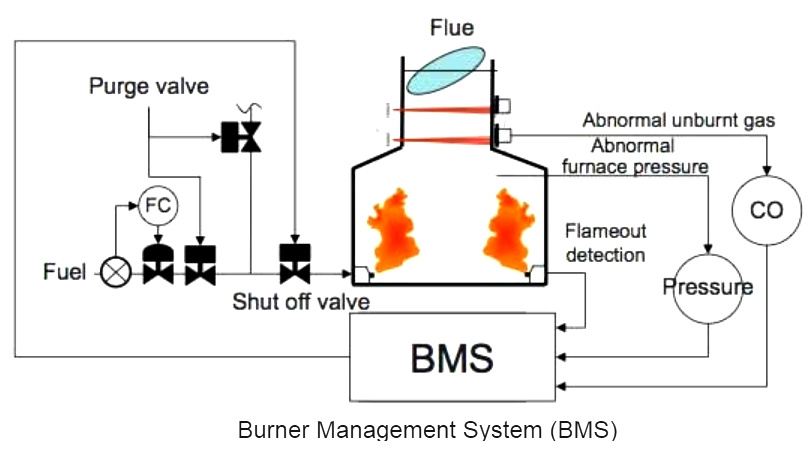A Burner Management System or BMS is a safety system used to assure safe start-up, operation and shut down of process burners.
The BMS can be used in industries like Oil and Gas, Power Generation, Chemical or any other process that uses an industrial burner, furnaces, boilers or other equipment that uses a flame.
Burner Management System
The system can monitor flames with flame detectors; it manages igniters, burners and actuators, like shut down valves.
The Burner Management System can have the following functions:
- Inhibit startup when the conditions are not met
- Monitor the burner to detect unsafe operating conditions
- Protect against unsafe operating conditions
- Shutdown interlocks
When the sensors don’t detect the flame or detects unsafe operating conditions, the BMS signals the actuators to stops the flow of fuel to the burners, to inhibit the flames.
In the industry there are 2 methods for implementing a BMS: Separated or integrated
The separated method is the traditional method of implementing a safety instrumented system (SIS) and a basic control system (BPCS). The SIS and BPCS logic solver are separated in two separate equipments. Also the workstations and the SCADA software for each other are separated. Both systems can communicate with each other using a bus and a common communication protocol.
The integrated method is a new method of implementing the solution. In this method the SIS and BPCS logic solver and workstations are on common equipment. The logic solver is a plc that respects the standards requested by the industry, like SIL3.
BMS functions:
- Prevent firing unless a satisfactory furnace purge has first been completed.
- Prohibit start-up of the equipment unless certain permissive interlocks have first been completed.
- Monitor and control the correct component sequencing during start-up and shut-down of the equipment.
- Conditionally allow the continued operation of the equipment only while certain safety interlocks remaining satisfied.
- Provide component condition feedback to the operator and, if so equipped, to the plant control systems and/or data loggers.
- Provide automatic supervision when the equipment is in service and provide means to make a Master Fuel Trip (MFT) should certain unacceptable firing conditions occur.
- Execute a MFT upon certain adverse unit operating conditions
Types of BMS:
- separate control
- integrated control
An integrated system offers:
- Integrated operating interface
- Integrated fire and gas detection system
- Integrated peer control
- Integrated power supply
- Integrated diagnosis
- Integrated security tools
- Integrated backup and recovery tools
- Integrated post-incident analysis
- Integrated simulation and optimization tools
- Fast data exchange due to direct communication
Advantages:
- Minimize intervention and shutdown time
- Recover more easily from process upsets
- Easier integration of components and systems
- Time synchronization is not needed
- Reduce hardware and installation cost by installing one system instead of two
- Minimize the quantity of spare parts
- Easier and less expensive engineering and maintenance
- Reduce the number of operating personal
- Reduce training requirements and time
- Improve accessibility
Disadvantages:
- Less flexible
- Two separate systems are easier to manage
- Separated systems lead to reduced long-term administrative costs
If there is a hardware fault, the other system’s independency keeps it functional.
Reference - sisfireandgas
